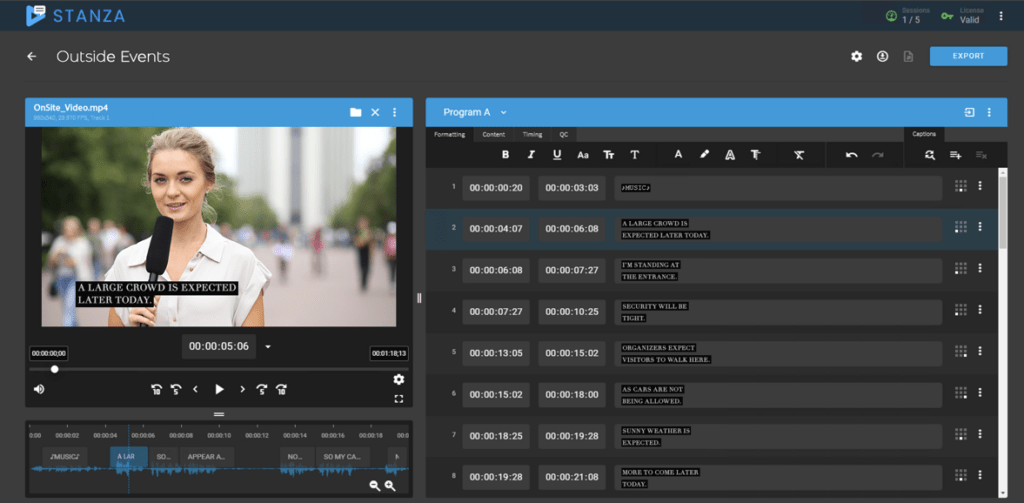Regulatory compliance has traditionally driven the use of closed captioning as a required part of any live or recorded broadcast regardless of the content. In the US, the Federal Communications Commission (FCC) issues rules that govern the use of closed captioning in broadcast programming. Other countries have also instituted their own closed captioning requirements for media programming including Canada, Australia, the EU, and the United Kingdom. While compliance will continue to be a key driver in the industry, captioning and subtitles are evolving beyond just simply providing accessibility. They are playing a broader role in enhancing engagement, expanding reach, and driving innovation in media.
As the demand for captioning and subtitling grows, media organizations are increasingly relying on advanced automated tools to streamline workflows and deliver broadcast-quality results to ensure compliance. Purpose-built and robust solutions like Telestream Stanza provide a turnkey approach that has been designed to specifically meet the rigorous requirements of broadcast environments.
Closed Captioning Versus Subtitling: The Same but Different
While closed captioning and subtitling are often used interchangeably, they serve distinct purposes and specific audiences. Both enhance accessibility and improve audience engagement by providing text-based representations of spoken dialogue synchronized with the audio. However, closed captions are designed for individuals who are deaf or hard of hearing. They offer not only the transcription of dialogue, but also non-verbal audio cues such as sound effects and music. Subtitles, in contrast, cater to multilingual audiences by just focusing on translating the spoken words into the local language. While both are valuable for accessibility and global reach, they fulfill unique roles within media production.
Stanza produces captions with detailed audio descriptions and generates accurate subtitles. At the heart of its capabilities is a custom engineered Stanza AI engine exclusive to Telestream. This advanced technology ensures accuracy, speed, and quality, all of which are essential for meeting professional broadcast standards.
Meeting FCC Requirements for Closed Captioning
FCC requirements for closed captioning of video programming are designed to ensure accessibility for viewers with hearing disabilities. These rules require accurate, synchronous, complete, and properly placed captions for the entirety of a program. The FCC requires that programs previously aired on television with captions, also be captioned when re-shown on the Internet.
While essential for compliance, captions now serve as strategic tools to improve content discoverability and enhance audience engagement.
Read on to learn how captioning is rising in popularity with viewer segments beyond the traditional hearing-impaired.
Driving Viewer Engagement Anywhere with Closed Captioning and Subtitling
Captions and subtitles enable seamless content consumption in diverse environments, from quiet offices to bustling airports. In a recent study of younger audiences, more than half of Gen Z and millennial respondents indicated that they prefer to use subtitles, when viewing content. The preference for enabling subtitles by younger generations while watching programming stems in part from their exposure to social media platforms where subtitles are not only common, but algorithmically promoted. They have become accustomed to consuming content in environments where videos are often muted by default, making subtitles essential.
Expanding Global Reach with Closed Captioning
Closed captioning also facilitates content localization, allowing producers to cater to non-native speakers and international audiences. By providing accurate transcriptions, captions can serve as a foundation for translating content into multiple languages. This enables content producers to maximize the value and reach of their content by expanding and adapting it for other regions.
Stanza offers fully integrated speech-to-text, using AI, for highly accurate transcription for multiple languages. Future enhancements to Stanza include text-to-text translation of captions between multiple major languages including German, Spanish, Portuguese, French, Italian, and more.
Ensuring Inclusivity and Brand Reputation
While captions are legally required, embracing them proactively demonstrates a commitment to inclusivity. Audiences increasingly value accessible content, and captions can help media brands build trust and strengthen their reputation. Broadcasters investing in high-quality, professional captions means going beyond compliance, to create a better viewing experience.
Closed Captioning: A Strategic Advantage for Media Professionals
Captions are no longer just about meeting regulatory regulations—they are a key driver for engagement, accessibility, and global scalability. By integrating captions throughout the production process, television and video professionals can future-proof their content and better serve a diverse audience.
As remote collaboration, digital consumption, and global connectivity continue to grow, the role of closed captioning in media production will only expand. Stay ahead by leveraging captions not just as a requirement but as a competitive advantage.
Professional Closed Captioning and Subtitling with Telestream Stanza
Stanza is the award-winning captioning solution for production companies and captioners. It improves content accessibility and compliance with custom-engineered, AI-powered speech-to-text transcription capabilities that comply with FCC regulations for TV and internet closed captioning. Stanza uses a browser-based editing console for easy access to media files from anywhere including remote locations across Windows, MacOS, and Linux with no expensive hardware required. It soon will offer enhanced captioning for text-to-text translation between multiple languages.
Contact us to learn more about Stanza or to schedule a personal demonstration.




